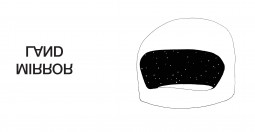Oto Hudec MIRROR LAND
“So when I have to choose to save a human, or a bee, I save a bee.”
In the beginning, there’s a news report announcing the discovery of a space ship in Central Slovakia. A beekeeper from the village of Dúbravica has built a beehive in the shape of a space ship so that he can take his bees to Mirror Land. This unspoiled planet is similar to ours and located on the other side of the sun. Although it seems unbelievable, this spaceship DBSP 01 (Dúbravica Beekeeper's Space Program) is real – it’s open to visitors in the middle of the village. You can even get a glimpse of a man in a space suit. Perhaps, this final ode to escapism is an ode to a justified getaway, or an ode to the work of beekeepers – those tied to bees, who despite the fact that they steal their honey, protect them and take care of their families. Understanding bees and their behavior requires a tranquil, calm and open mind.
This story takes place in various time zones, the present and the future, flowing along the plot lines between reality and fiction. It takes place in a kind of timeless cosmic travelling. The plot can be perceived as an interior dialogue between two figures – a journalist and an astronaut. They have two independent, overlapping axes – the literary story and the artistic work combined in a whole. The scenes referring to the archaic and rurally anchored values of beekeeping intertwine with the modern myth of cosmic escape. Instead of the optimistic idea of cosmic discovery, the text resonates with the fear for the fate of bees who are invisibly connected to everything we experience, namely our entire day-to-day existence. However, attention is also directed elsewhere: the story isn’t only a warning about ecological catastrophe and the loss of the delicate equilibrium of nature. It invites us into a world where time passes differently. As soon as the astronaut takes off his helmet, he hears an entire spectrum of the sounds of nature and is immersed in it.
Daniel Grúň
Notes
This book was published by tranzit.sk in cooperation with the Apart Label collective. The graphic design was done by Magdaléna Scheryová. The project was initiated by the Periférne centrá association and presented as an exhibition at the Gandy Gallery with the title, The Man who travels with Bees (2016).
